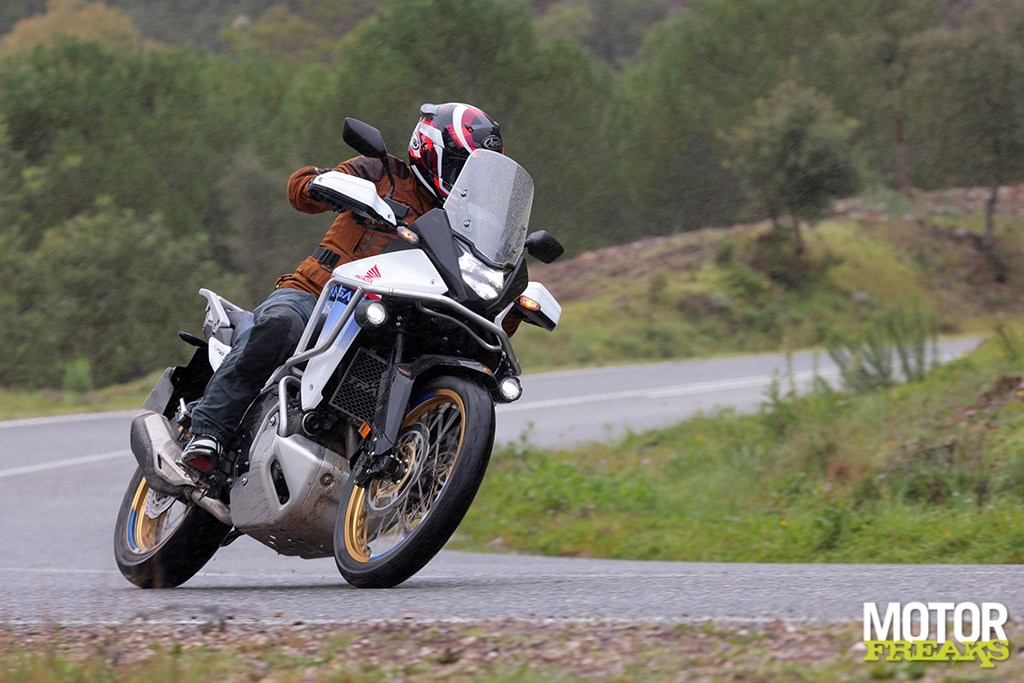Thirty-six years after the launch of the very first Transalp, Honda has breathed new life into its popular Allroad. In the Algarve we were introduced to the XL750 Transalp, which has significantly hotter peppers. An extensive test will soon be available on Motorfreaks, here are our first findings.

“It’s the Transalp, to which Tabasco has been added to give it a big boost,” said Paul Nowers of Honda Motor Europe during the presentation of the XL750 Transalp, the second model after the Hornet based on the new 755cc 270 ° parallel twin and the second model where Honda has breathed new life into an old and legendary name.
Launched in 1987 as the XL600V, the Transalp was the first Allroad to be marketed by Honda. The origin of the bicycle lay in the famous Paris-Dakar rally, but it was developed as a motorcycle that had to be able to easily cross mountains and was therefore also named Transalp. A motorcycle that combined off-road use with long-distance comfort on paved roads.
In 2000, the XL600V was succeeded by the XL650V, which featured the same 650cc V-twin that Honda had used in the NT650 Revere and NT650V Deauville. After just 7 years, the third generation was launched, with the V-twin again upgraded – this time to 680cc – and the engine now known as the XL700V Transalp. Twenty-six years after its introduction, the curtain fell on the Transalp in 2013.
Although it would remain silent for a decade, in recent years it was increasingly rumored that Honda was working on a smaller version of the Africa Twin, which after its resurrection in 2015 had grown into a successful counterpart to the o-so popular GS. The rumors gained momentum last year when it appeared that Honda had re-established the XL750 Transalp name. A few months later, the bike was officially confirmed by Honda as a 2023 model.

For a first introduction, Honda had set out a route of almost 180 kilometers through the hilly hinterland in the Algarve, where the Transalp could be tested in its habitat, but if the rain comes pouring down from the sky at night, I ask I wonder if we’ll get to taste Paul Nowers’ Tabasco at all.
This will be discussed in depth in the extensive test, but we can and want to tell you right now that Honda couldn’t have done better than with the bad weather of the morning. From the first meters the Transalp felt so incredibly familiar that we just wanted to push despite the bad weather. And we were lucky that our front driver wasn’t averse to that either.
To sum it up for you: the Transalp looks and feels much more like a mature bike than a mid-range bike that can be made suitable for A2. With a fresh design, in which the lines of the first Transalp can be recognized and a beautiful finish, the looks are well done, but at least as important is that it all feels very solid. This is not a cheap bike from AliExpress.
The mature look is also reflected in the 5″ TFT color display, which has no less than 4 different layouts, so that it will really appeal to everyone. Even more important than the design is the operation from the steering wheel, which is really much more user-friendly than at the Africa Twin, which in that respect really leans towards higher mathematics.

The 755cc parallel twin runs incredibly smoothly and delivers power very linearly, with peak power output of 92PS at 9,500rpm and maximum torque of 75Nm at 7,250rpm. Precisely because of that linear delivery and the fact that the engine continues to build power until just before the limiter, the engine prefers to be above 8,000 rpm at a sporty pace. The block feels so incredibly familiar that you dare to turn the gas full against the butt at all times, rain or shine.
The block seems almost perfectly balanced with the bicycle part. The Transalp steers very light and direct, with so much feedback and confidence from the 21″ front wheel that you dare to push the bike into the corner on wet roads in the rain as if the sun were high in the sky. Big kudos too to the Metzeler rubber.
However, all that glitters is not gold, especially in Rain mode the initial throttle response proves to be too direct when the needle is between 4,000 and 6,000 rpm in the corner, which seems to be partly due to the engine braking being strongest in that mode. are caused.
In addition, the engine transmits slight vibrations to the footpegs, although it should be noted that we drove with the off-road footpegs. Furthermore, the notes also state as a downside that we would have liked to see an adjustable windshield.
So far our first findings of the new Transalp, the extensive test will be put online soon.

– Thanks for information from Motorfreaks.